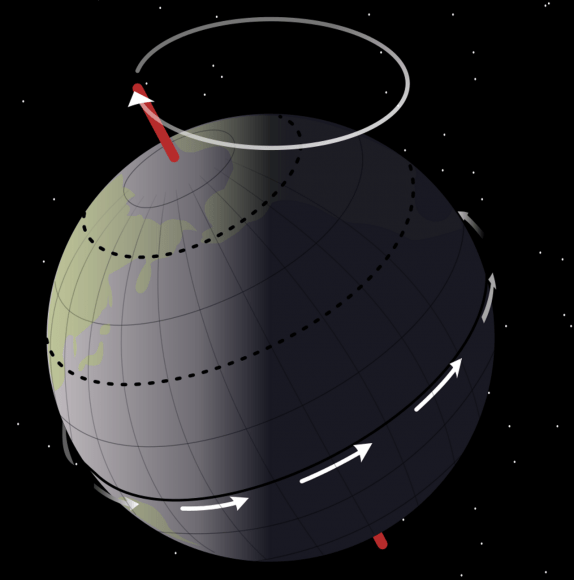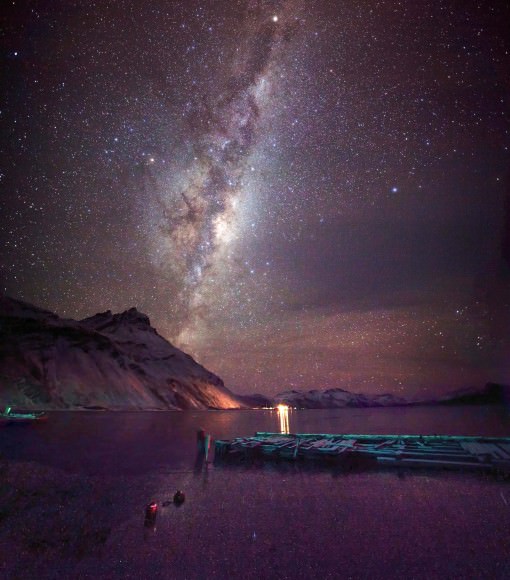For most of here on planet Earth, sunrise, sunset, and the cycle of day and night (aka. the diurnal cycle) are just simple facts of life. As a result of seasonal changes that happen with every passing year, the length of day and night can vary – and be either longer or shorter – by just a few hours. But in some regions of the world (i.e. the poles) the Sun does not set during certain times of the year. And there are also seasonal periods where a single night can last many days.
Naturally, this gives rise to certain questions. Namely, what causes the cycle of day and night, and why don’t all places on the planet experience the same patterns? As with many other seasonal experiences, the answer has to do with two facts: One, the Earth rotates on its axis as it orbits the Sun. And two, the fact that Earth’s axis is tilted.
Earth’s Rotation:
Earth’s rotation occurs from west to east, which is why the Sun always appears to be rising on the eastern horizon and setting on the western. If you could view the Earth from above, looking down at the northern polar region, the planet would appear to be rotating counter-clockwise. However, viewed from the southern polar region, it appears to be rotating clockwise.

The Earth rotates once in about 24 hours with respect to the Sun and once every 23 hours 56 minutes and 4 seconds with respect to the stars. What’s more, its central axis is aligned with two stars. The northern axis points outward to Polaris, hence why it is called “the North Star”, while its southern axis points to Sigma Octantis.
Axial Tilt:
As already noted, due to the Earth’s axial tilt (or obliquity), day and night are not evenly divided. If the Earth’s axis were perpendicular to its orbital plane around the Sun, all places on Earth would experience equal amounts of day and night (i.e. 12 hours of day and night, respectively) every day during the year and there would be no seasonal variability.
Instead, at any given time of the year, one hemisphere is pointed slightly more towards the Sun, leaving the other pointed away. During this time, one hemisphere will be experiencing warmer temperatures and longer days while the other will experience colder temperatures and longer nights.
Seasonal Changes:
Of course, since the Earth is rotating around the Sun and not just on its axis, this process is reversed during the course of a year. Every six months, the Earth undergoes a half orbit and changes positions to the other side of the Sun, allowing the other hemisphere to experience longer days and warmer temperatures.

Consequently, in extreme places like the North and South pole, daylight or nighttime can last for days. Those times of the year when the northern and southern hemispheres experience their longest days and nights are called solstices, which occur twice a year for the northern and southern hemispheres.
The Summer Solstice takes place between June 20th and 22nd in the northern hemisphere and between December 20th and 23rd each year in the southern hemisphere. The Winter Solstice occurs at the same time but in reverse – between Dec. 20th and 23rd for the northern hemisphere and June 20th and 22nd for the southern hemisphere.
According to NOAA, around the Winter Solstice at the North Pole there will be no sunlight or even twilight beginning in early October, and the darkness lasts until the beginning of dawn in early March. Conversely, around the Summer Solstice, the North Pole stays in full sunlight all day long throughout the entire summer (unless there are clouds). After the Summer Solstice, the sun starts to sink towards the horizon.
Another common feature in the cycle of day and night is the visibility of the Moon, the stars, and other celestial bodies. Technically, we don’t always see the Moon at night. On certain days, when the Moon is well-positioned between the Earth and the Sun, it is visible during the daytime. However, the stars and other planets of our Solar System are only visible at night after the Sun has fully set.

The reason for this is because the light of these objects is too faint to be seen during daylight hours. The Sun, being the closest star to us and the most radiant object visible from Earth, naturally obscures them when it is overhead. However, with the Earth tilted away from the Sun, we are able to see the Moon radiating the Sun’s light more clearly, and the stars light is detectable.
On an especially clear night, and assuming light pollution is not a major factor, the glowing band of the Milky Way and other clouds of dust and gas may also be visible in the night sky. These objects are more distant than the stars in our vicinity of the Galaxy, and therefore have less luminosity and are more difficult to see.
Another interesting thing about the cycle of day and night is that it is getting slower with time. This is due to the tidal effects the Moon has on Earth’s rotation, which is making days longer (but only marginally). According to atomic clocks around the world, the modern day is about 1.7 milliseconds longer than it was a century ago – a change which may require the addition of more leap seconds in the future.
We have many interesting articles on Earth’s Rotation here at Universe Today. To learn more about solstices here in Universe Today, be sure to check out our articles on the Shortest Day of the Year and the Summer Solstice.
More information can be found at NASA, Seasons of the Year, The Sun at Solstice
Check out this podcast at Astronomy Cast: The Life of the Sun

